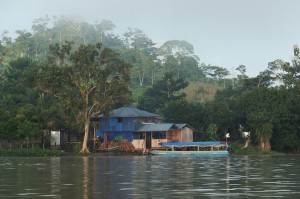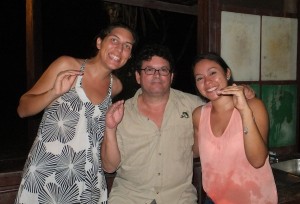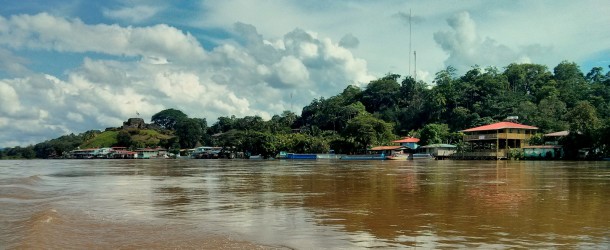After a delightful 10-day rest-stop on the very peaceful island of Ometepe, I am off once again, this time to the mythical San Juan River. I spend the night on the ferry on my way to San Carlos, on the south-eastern end of the lake. Then, I get in a second (much smaller) boat, all the while engrossed in Stevenson’s “Treasure Island” (thank you Guillaume; this book ties in perfectly with my present environment!). Three hours later, I meet Agustin, and it is after getting on a third (and even tinier) boat that I finally step into my new eco-lodge, one with the very intriguing name of “Montecristo”…
Rio San Juan: Historical Greatness and Decline
 Have you ever heard of the Rio San Juan? This wide and lengthy river almost 200 km. long travels down through dense virginal jungle that is tropical and damp (i.e. a true “Rainforest”), and connects the Atlantic Ocean to Lake Nicaragua, that large lake that is itself a mere 18 km. from the Pacific Ocean at its narrowest point (the Rivas Isthmus).
Have you ever heard of the Rio San Juan? This wide and lengthy river almost 200 km. long travels down through dense virginal jungle that is tropical and damp (i.e. a true “Rainforest”), and connects the Atlantic Ocean to Lake Nicaragua, that large lake that is itself a mere 18 km. from the Pacific Ocean at its narrowest point (the Rivas Isthmus).
During colonial times, in gold-prospecting days, the San Juan River was for these reasons a major communication route in the area. Not far from the lake, the famous city of Granada (the #1 touristic destination as depicted on pamphlets about Nicaragua), would not have become so very rich were it not for the San Juan River. In fact, because of it, Granada became one of the main river ports leading to the Atlantic, and this despite the fact that it lay inland! However, pirates were also known to sail up the river … and so, after one attack too many, the Spanish decided to build a fort to protect this strategic route, and so the little town of “El Castillo” was born.
In the past, moreover, many plans had been made to build an interoceanic canal through the Rio San Juan … up until the day when the Panama Canal project materialized, and when sources of gold dried up. And so the settlers abandoned the region.
I rarely describe a region’s history this way, and in detail, on this blog but I found the place quite captivating, and it seems to me rather important and interesting to know all of this to better understand the present-day issues and challenges facing tourism in that region.
An Eco-Destination with a Promising Future?
 Once the present-day canal project was confirmed (see the article on the Totoco Ecolodge, Island of Ometepe), different routes were suggested, one of which passed along the San Juan River. Consequently, the entire region was plunged into an endless waiting period for a while … No one wanted to invest should the canal indeed pass that way. However, according to the latest news (maybe also because of eternal conflicts between Nicaragua and Costa Rica who both claim ownership of the river?) it has been announced that the canal will not pass that way; saved by the bell!!! Well, at least the Rio San Juan is spared … but as for further north, where the canal is supposed to pass through tropical forests and dislodge hundreds of families and farms at a ridiculously low compensation rate, that is another story…
Once the present-day canal project was confirmed (see the article on the Totoco Ecolodge, Island of Ometepe), different routes were suggested, one of which passed along the San Juan River. Consequently, the entire region was plunged into an endless waiting period for a while … No one wanted to invest should the canal indeed pass that way. However, according to the latest news (maybe also because of eternal conflicts between Nicaragua and Costa Rica who both claim ownership of the river?) it has been announced that the canal will not pass that way; saved by the bell!!! Well, at least the Rio San Juan is spared … but as for further north, where the canal is supposed to pass through tropical forests and dislodge hundreds of families and farms at a ridiculously low compensation rate, that is another story…
You can only reach the little town of El Castillo by boat (there is in fact a road but you need an extremely powerful 4X4 and during the rainy season, well, good luck!) all of which, I find, contributes a lot to the charming and “secret-and-exclusive-treasure” aspects of the place.
The spot has everything going for it to become a new and precious eco-tourism destination: proximity to Costa Rica (where tourism is booming), a rich history, protected biodiversity, etc.
Montecristo River Lodge, A Great Investment Opportunity!
 It is against this background that I get to know Agustin and his River Lodge Montecristo, situated right next to the village of Boca del Sabalo at 6 km. from El Castillo.
It is against this background that I get to know Agustin and his River Lodge Montecristo, situated right next to the village of Boca del Sabalo at 6 km. from El Castillo.
Agustin’s father was Nica (local expression for ‘from Nicaragua’), and his mother American. Fourteen years ago, he invested in a piece of land on the edge of the river, converted 70 hectares into a protected nature reserve, and built eight bungalows, bestowing on all of this an environmentally respectful managing system (i.e. solar panels, sceptic tank, separated and recycled garbage …) He named the place “Montecristo” in memory of the farm of the same name that his father once owned. Passionate about fishing (especially tarpon-fishing), his clientele mainly consists of Canadian families and couples. Just take a look at the fabulous comments posted on TripAdvisor; one can quickly understand what people come here in search of (and in fact find easily): the jungle experience, a real one! I’ve never travelled to the Amazon (at least, not yet …), but the impression that I have about it in my head tells me that, around here, it is a sort of smaller Central American Amazon.
Now that we know that the canal will not pass through the river, Agustin will soon be launching an improved and enhanced website. Incidentally, he intends to start renovations, continue improving his lodge, and build more bungalows, all the while continuing to put more sustainable practices in place. My advice to prospective investors: the awakening of Rio San Juan is happening now! 😉
Translated by Hélène Masson from Quebec
volunteering in Nicaragua to teach English

